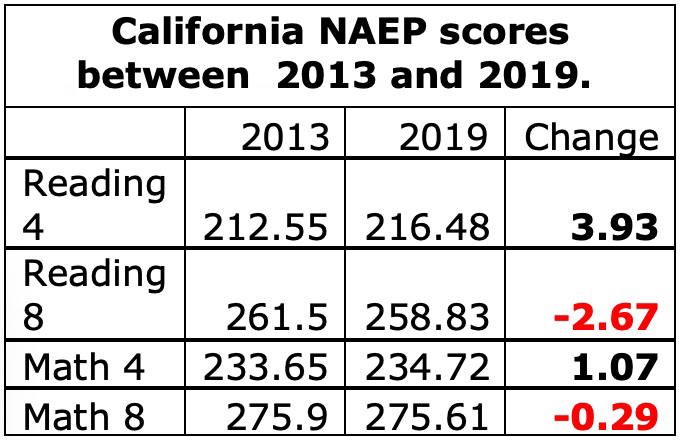In a recent blog, Dr. Michael Kirst, past president of the California State Board of Education between 2011 and 2019, attempts to defend his record of Common Core implementation in California during that period.
His first point goes to the fidelity of NAEP as a measuring tool, since it is not perfectly aligned with Common Core. Indeed it is not—purposely! NAEP was not designed to be aligned with any particular state standards and that has been true for decades. This hasn’t blocked states from exhibiting improvements over time, sometimes smoothly, sometimes in spurts. But the results on NAEP almost never—never!—declined.
Under Common Core, in the 2015, 2017, and 2019 administration of NAEP scores broadly and significantly declined across most states, including California.
Yet Dr. Kirst starts by blaming the national yardstick that has served us faithfully for decades. What does that say about the quality of his “rebuttal”?
Then Dr. Kirst turns to argue that California has made significant improvement since Common Core. His evidence? A 10% improvement in grades 3 and 4 over four years of SBAC administration. What was politely glossed over is the fact that half of this change occurred between the first administrations, when young students first confronted new ways to answer computer-based items with new formats and a new interface, and the second administration when they had an opportunity to practice and adjust to them. If we remove the first SBAC administration, the change from 2015 to 2019 are rather unimpressive 5-6% in early grades that declines to essentially zero or even slightly negative by grades 8 and 11.

Yet this raises another question. Is SBAC test even valid, both facially (do its items sample actual subject matter content?) and psychometrically (does item format allows us to reliably interpret the results, give the new fancy and untested formats introduced by it?). The answer is nobody knows, as no external experts were given access to validate that test.
Here is the little we do know—since California abolished under Common Core almost any continuous measure of achievement.
During Common Core, California students taking Algebra I in grade 8 dropped from 54% in 2013 just before Common Core started, to 18% by 2019. A two thirds drop in six years!
And here are California NAEP scores for that period. With the exception of fourth grade reading, the results are flat or negative.

Incidentally, we also know that successful Black AB Calculus takers dropped by almost half between 2014 and 2018, and successful Black BC Calculus dropped by one third. That is what we know about California achievement from objective sources since Common Core took over in 2014.
We don’t know how many students successfully took Algebra 1 in middle and high schools—that test was eliminated in Calfornia under Common Core. We don’t know how many students successfully took Geometry or Algebra 2—those tests were eliminated under Common Core. We don’t know how many students are truly ready for the California State University System—that customized test for CSU was replaced by some arbitrary passing score on SBAC.
So we don’t know a lot. The public can no longer track what is really occurring in California education. Clear test-based accountability has been replaced by meaningless colorful dashboards based on the single unvalidated test: the SBAC.
So this is California reality, rather than the tiny improvement sliver Dr. Kirst attempts to present as the whole picture. But what about the future? Kirst promises that things will just get better, instructional materials exist (well, they existed at least since 2014, many of them free), and the future is bright.
Is it?
In 2011, the authors of this article talked with Dr. Kirst to make sure he understood the problems with the Common Core validation by David Conley, and that the previous California standards were judged superior. Nothing was done.
In 2013 Kirst was informed by us in detail as to why the New Generation Science Standards were inferior to the then-current California science standards. This was at the time of a scathing report in June 2013 from the Fordham Institute showing the NGSS to be, effectively, content-empty. Kirst assured us that he was aware of these drawbacks and that California would not adopt NGSS.
In September 2013 Dr. Kirst presided over the adoption of NGSS for California.
Today in California, after 8 years of Dr. Kirst’s state board presidency, we have a system that has no external accountability, where everything is being based on an internal secret test. We have inferior science standards and a system that has seemingly declined in performance. Denigrating NAEP, the only external measure left, is not a very good argument.









